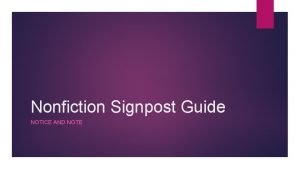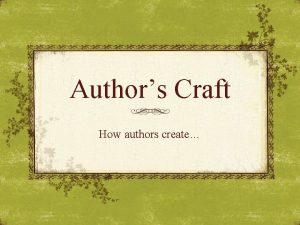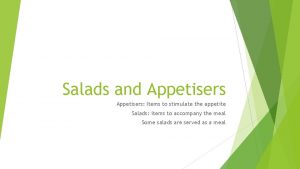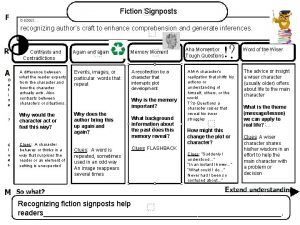Nonfiction Signposts recognizing authors craft to enhance comprehension


- Slides: 2

Nonfiction Signposts recognizing author’s craft to enhance comprehension and generate inferences. Contrasts and Contradictions D e f i n e ? C l u e s Quoted words Word Gaps Extreme and Absolute language Statistics and Numbers When the author shows you how things/people/ideas contrast or contradict (argue) on another When the author uses language that leaves no doubt about a situation or seems to exaggerate When the author uses specific quantities or comparisons to show amount, size, or scale. When the author includes opinions of someone who is an expert When the author uses unfamiliar vocabulary. What is the difference and why does it matter? Why did the author use this language? Why is the author use (or not use) numbers? Does it seem like technical talk for this topic? Direct signals : On the other hand, by contrast, however, another viewpoint is… You think: We don’t live like this Or our government isn’t that way… Direct signals : all, none, everyone, always, never, totally Why is this person quoted? What does this quote add to the text? Direct signals : 90%, 3, 400, 1 out of every 10, four times as many Direct signals : Doctor Soandso, Professor Context Clues 1. Prefix, Suffix, Root? 2. Synonyms or Antonyms? 3. Read around the work… 4. LOOK it UP! You think: It is not possible for ALL people ALWAYS to… You think: Why do I need to know how many, most, some, or taller than… Soandso, “……” You think: Can I trust this quote? Do I know this word from somewhere else? Recognizing nonfiction signposts help readers_____________________________.

The FRAME Routine Key Topic Nonfiction Big ? s is about… gaining a questioning stance to help readers critically think about a real issue. Main idea Big Question 1 Essential details What surprised me? Details reader should think about during and after reading Big Question 2 Main idea Big Question 3 Essential details What did the author think I already knew? Essential details What changed, challenged, or confirmed what you already knew? I was shocked when… I never thought… Really? I could not believe… I did not know… I was confused by… The author assumed/thought I knew… At first I thought___but… I had to rethink… I changed my mind when… I was right/wrong about… -new info (I didn’t know that!) -suspicious info (Really…is that true? ) -clarifying info (Oh! Now I get it!) -different perspectives (I hadn’t thought of it that way. ) -visualize (The author thought I could picture this. ) -prior knowledge (The author thought I knew about it before. ) -sequence/causal relationships (The author thought I would understand how this happens. ) -We read nonfiction to learn. -Learning involves changing the way we think about an issue or idea. -We can change is several ways. 1. Confirm what we know. 2. Modify our thinking 3. Change our minds completely So What? (What’s important to understand about this? ) Asking myself the BIG 3 BEFFORE I decide on a multiple choice answer will help me think critically and prevent me from making mistakes.



